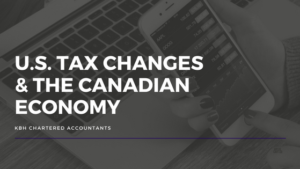U.S. tax reform is here! Wait… In Canada, really? In reality, these changes do effect Canadian business. After President Trump signed off on the latest version of the U.S. tax code, that sweeping overhaul has become “law”. As a result, our Canadian businesses with cross-border ties need to be cognizant of what lies ahead.
As Canadian businesses have always been major stakeholders in U.S. tax reform, and our economy being deeply integrated with the U.S. economy (see our post on the U.S. government and how it could effect us), the shifts in U.S. taxation will hit the bottom lines of much of corporate Canada.
It’s difficult to predict the full impact of the U.S. tax reform on the Canadian economy, it’s safe to say that it will be far reaching across a multitude of industries. Optimistically, these changes to the tax reform may shift thinking, create new economic incentives and, for those prepared, create opportunity. With that being said, we hope to prepare you as much as possible!
Some changes to note are:
- Reduction in the Federal corporate rate from 35% to 21% effective January 1, 2018. When state taxes are considered the top tax rate in the US will be comparable to the top tax rate in Canada.
- The deduction for certain depreciable property will be increased to 100% for certain property purchased between September 27, 2017 and December 31, 2022.
- Net operating losses that are carried forward may not be used to offset more than 80% of the taxable income in the current year. Net operating losses generated in 2018 and beyond may no longer be carried back to prior years and will carry forward indefinitely (previously was limited to 20 years).
- Limits have been put in place restricting interest deductions in corporations. The interest deduction cannot exceed 30% of adjusted taxable income. The adjusted taxable income will equal EBIDTA for the 2018 to 2022 taxation years. For 2022 and on, the adjusted taxable income will be equal to EBIT. Any interest that is non-deductible can be carried forward indefinitely to a later year. There is no grandfathering of pre-2018 debt.
- The top federal personal rate was reduced to 37% effective for the 2018 taxation year. However, this rate reduction is only effective until the end of 2025. The high rate will apply on income in excess of $300,000 (or $600,000 if filing a coupled return). The US individual rates will be slightly lower than the Canadian taxes.
- Moving expenses will no longer be deductible in the US and Alimony payments will no longer be deductible for divorces executed after December 31, 2018.
- The interest deduction for a primary residence will be limited to $750,000 of principal until the end of 2025.
- One-Time Repatriation Tax – this tax will be charged on the accumulated earnings and profits of a foreign corporation earned in years after 1986. Where a US person owns at least 10% of the foreign corporation then the transition tax will be charged at a rate of 8% – 15.5% depending on the assets of the corporation. This tax can either be paid in a lump sum or spread out over eight years. Any future dividends from the foreign corporation would not be subject to additional US tax.
- Global Intangible Low-Tax Income (GILTI) – after December 31, 2017 all US shareholders of a Controlled Foreign Corporation that holds foreign intangible assets will be subject to a minimum tax of 10.5% on the GILTI.
- The US estate and gift tax unified credit was increased after December 31, 2017 and before January 2, 2026 to $11.81 million. Any estate below $11.81 million will have no estate tax payable.
Contact your trusted KBH advisor for any specific questions you have related to your business: info @kbh.ca
